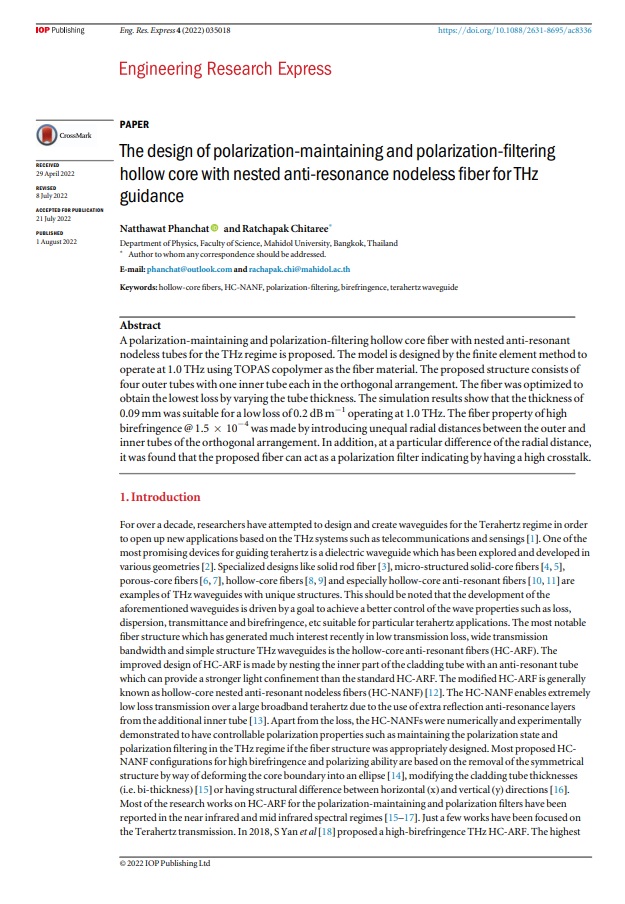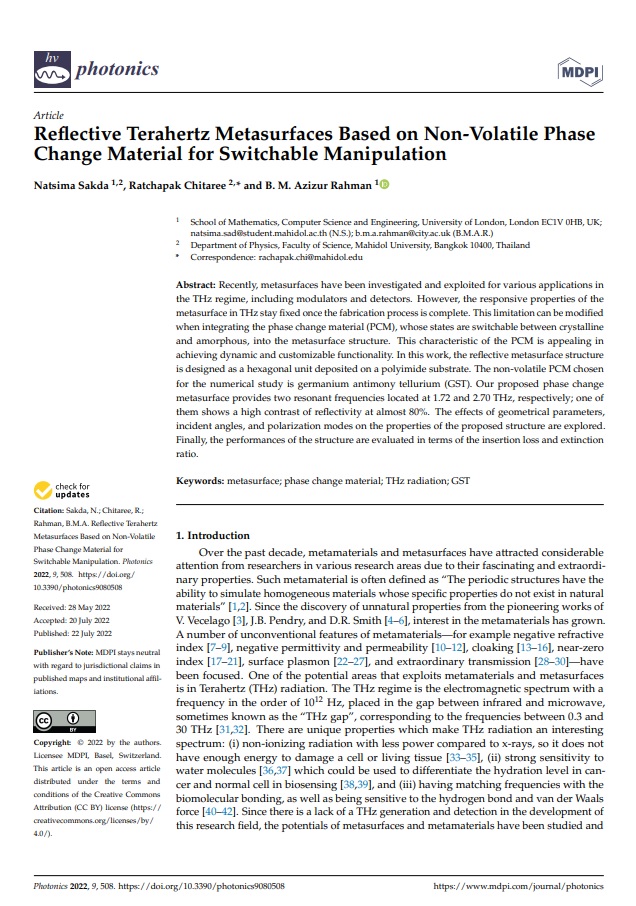Recent publications'22
1. The design of polarization-maintaining and polarization-filtering hollow core with nested anti-resonance nodeless fiber for THz guidance [1 August 2022]

https://doi.org/10.1088/2631-8695/ac8336
Abstract
A polarization-maintaining and polarization-filtering hollow core fiber with nested anti-resonant nodeless tubes for the THz regime is proposed. The model is designed by the finite element method to operate at 1.0 THz using TOPAS copolymer as the fiber material. The proposed structure consists of four outer tubes with one inner tube each in the orthogonal arrangement. The fiber was optimized to obtain the lowest loss by varying the tube thickness. The simulation results show that the thickness of 0.09 mm was suitable for a low loss of 0.2 dB m−1 operating at 1.0 THz. The fiber property of high birefringence @ 1.5 × 10−4 was made by introducing unequal radial distances between the outer and inner tubes of the orthogonal arrangement. In addition, at a particular difference of the radial distance, it was found that the proposed fiber can act as a polarization filter indicating by having a high crosstalk.
2. Reflective Terahertz Metasurfaces Based on Non-Volatile Phase Change Material for Switchable Manipulation [22 July 2022]

https://doi.org/10.3390/photonics9080508
Abstract
Recently, metasurfaces have been investigated and exploited for various applications in the THz regime, including modulators and detectors. However, the responsive properties of the metasurface in THz stay fixed once the fabrication process is complete. This limitation can be modified when integrating the phase change material (PCM), whose states are switchable between crystalline and amorphous, into the metasurface structure. This characteristic of the PCM is appealing in achieving dynamic and customizable functionality. In this work, the reflective metasurface structure is designed as a hexagonal unit deposited on a polyimide substrate. The non-volatile PCM chosen for the numerical study is germanium antimony tellurium (GST). Our proposed phase change metasurface provides two resonant frequencies located at 1.72 and 2.70 THz, respectively; one of them shows a high contrast of reflectivity at almost 80%. The effects of geometrical parameters, incident angles, and polarization modes on the properties of the proposed structure are explored. Finally, the performances of the structure are evaluated in terms of the insertion loss and extinction ratio.
3. Discriminant Analysis PCA-LDA Assisted Surface-Enhanced Raman Spectroscopy for Direct Identification of Malaria-Infected Red Blood Cells [10 June 2022]

https://doi.org/10.3390/mps5030049
Abstract
Various methods for detecting malaria have been developed in recent years, each with its own set of advantages. These methods include microscopic, antigen-based, and molecular-based analysis of blood samples. This study aimed to develop a new, alternative procedure for clinical use by using a large data set of surface-enhanced Raman spectra to distinguish normal and infected red blood cells. PCA-LDA algorithms were used to produce models for separating P. falciparum (3D7)-infected red blood cells and normal red blood cells based on their Raman spectra. Both average normalized spectra and spectral imaging were considered. However, these initial spectra could hardly differentiate normal cells from the infected cells. Then, discrimination analysis was applied to assist in the classification and visualization of the different spectral data sets. The results showed a clear separation in the PCA-LDA coordinate. A blind test was also carried out to evaluate the efficiency of the PCA-LDA separation model and achieved a prediction accuracy of up to 80%. Considering that the PCA-LDA separation accuracy will improve when a larger set of training data is incorporated into the existing database, the proposed method could be highly effective for the identification of malaria-infected red blood cells.
4. Extruded TOPAS hollow-core anti-resonant fiber optimized for THz guidance at 0.9THz [5 April 2022]

DOI:https://doi.org/10.1364/OE.450550
Abstract
A hollow-core anti-resonant fiber for the THz regime is proposed and demonstrated. The proposed fiber is the hexagonal core shape which is directly extruded using a conventional 3D printer. Experimental results show that by using cyclic olefin copolymer (COC), the proposed fiber design provides a low attenuation of ∼3 dB∕m at ∼ 0.86 THz and ∼15 dB∕m at ∼ 0.42 THz.
5. Performance optimization of a metasurface incorporating non-volatile phase change material [4 April 2022]

DOI:https://doi.org/10.1364/OE.453612
Abstract
Optical metasurface is a combination of manufactured periodic patterns of many artificial nanostructured unit cells, which can provide unique and attractive optical and electrical properties. Additionally, the function of the metasurface can be altered by adjusting the metasurface’s size and configuration to satisfy a particular required property. However, once it is fabricated, such specific property is fixed and cannot be changed. Here, phase change material (PCM) can play an important role due to its two distinct states during the phase transition, referred to as amorphous and crystalline states, which exhibit significantly different refractive indices, particularly in the infrared wavelength. Therefore, a combination of metasurface with a phase change material may be attractive for achieving agile and tunable functions. In this paper, we numerically investigate an array of silicon cylinders with a thin PCM layer at their centers. The GST and GSST are the most well-known PCMs and were chosen for this study due to their non-volatile properties. This structure produces two resonant modes, magnetic dipole and electric dipole, at two different resonating wavelengths. We have numerically simulated the effect of cylinder’s height and diameter on the reflecting profile, including the effect of thickness of the phase change material. Additionally, it is shown here that a superior performance can be achieved towards reduced insertion loss, enhanced extinction ratio, and increased figure of merit when a GST layer is replaced by a GSST layer.
6. Optical Fiber, Nanomaterial, and THz-Metasurface-Mediated Nano-Biosensors: A Review [14 January 2022]

DOI:https://doi.org/10.3390/bios12010042
Abstract
The increasing use of nanomaterials and scalable, high-yield nanofabrication process are revolutionizing the development of novel biosensors. Over the past decades, researches on nanotechnology-mediated biosensing have been on the forefront due to their potential application in healthcare, pharmaceutical, cell diagnosis, drug delivery, and water and air quality monitoring. The advancement of nanoscale science relies on a better understanding of theory, manufacturing and fabrication practices, and the application specific methods. The topology and tunable properties of nanoparticles, a part of nanoscale science, can be changed by different manufacturing processes, which separate them from their bulk counterparts. In the recent past, different nanostructures, such as nanosphere, nanorods, nanofiber, core–shell nanoparticles, nanotubes, and thin films, have been exploited to enhance the detectability of labelled or label-free biological molecules with a high accuracy. Furthermore, these engineered-materials-associated transducing devices, e.g., optical waveguides and metasurface-based scattering media, widened the horizon of biosensors over a broad wavelength range from deep-ultraviolet to far-infrared. This review provides a comprehensive overview of the major scientific achievements in nano-biosensors based on optical fiber, nanomaterials and terahertz-domain metasurface-based refractometric, labelled and label-free nano-biosensors.